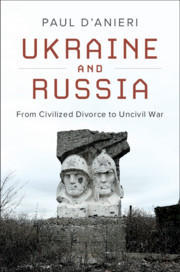Book contents
- Ukraine and Russia
- Ukraine and Russia
- Copyright page
- Dedication
- Contents
- Maps
- Tables
- Acknowledgments
- Additional material
- 1 The Sources of Conflict over Ukraine
- 2 New World Order? 1989‒1993
- 3 Hope and Hardship, 1994‒1999
- 4 Autocracy and Revolution, 1999‒2004
- 5 Reform and Reversal, 2004‒2010
- 6 Viktor Yanukovych and the Path to Confrontation, 2010‒2013
- 7 From Revolution to War, 2013‒2015
- 8 Conclusion: Ukraine, Russia, and the West ‒ from Cold War to Cold War
- Index
7 - From Revolution to War, 2013‒2015
Published online by Cambridge University Press: 01 November 2019
- Ukraine and Russia
- Ukraine and Russia
- Copyright page
- Dedication
- Contents
- Maps
- Tables
- Acknowledgments
- Additional material
- 1 The Sources of Conflict over Ukraine
- 2 New World Order? 1989‒1993
- 3 Hope and Hardship, 1994‒1999
- 4 Autocracy and Revolution, 1999‒2004
- 5 Reform and Reversal, 2004‒2010
- 6 Viktor Yanukovych and the Path to Confrontation, 2010‒2013
- 7 From Revolution to War, 2013‒2015
- 8 Conclusion: Ukraine, Russia, and the West ‒ from Cold War to Cold War
- Index
Summary
The delay of the Association Agreement spurred protests, and violent repression caused them to grow. Yanukovych’s ouster outraged Putin, who again saw a revolution thwart Russia’s position in Ukraine. He saw an irresistible opportunity to respond. Seizing Crimea regained a territory Russia had always wanted; it showed that Russia could defy the West; it boosted Putin’s domestic popularity; and it hamstrung Ukraine’s new government. The conflict then spread to eastern Ukraine, where the shooting down of a passenger aircraft dramatically increased international outrage at Russia’s actions. The West enacted sanctions, while the conflict itself stabilized territorially in the February 2015 Minsk-2 agreement.
- Type
- Chapter
- Information
- Ukraine and RussiaFrom Civilied Divorce to Uncivil War, pp. 211 - 252Publisher: Cambridge University PressPrint publication year: 2019

